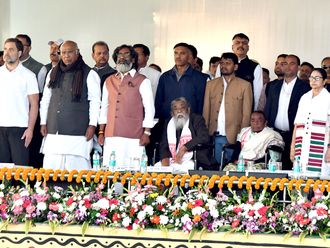It comes as no surprise that the Modi government decided to surprise everyone by suddenly clearing the way towards simultaneous polls and once again, changing the conversation and the narrative about a “weaker” NDA 3.0.
As the Modi government completed 100 days of its third term, with several policy U-turns as it came under pressure from the opposition and allies, the One Nation, One Election rabbit was pulled out of the hat.
The Union cabinet cleared the report submitted by a committee headed by former President Ramnath Kovind, which of course endorsed simultaneous polls for parliament and state legislatures. The sanctity of the entire process, which will upend the entire federal structure of India, was questionable.
For one, the committee did not have a single regional party representative. No Chief Minister, no regional leader at all. There was the token announcement of the Congress party’s Adhir Ranjan Choudhary (who refused to be part of it, calling it an “eyewash”), and the others who were there had already expressed views in support of the idea propagated by the BJP or generally expressed support to the central government.
The committee’s terms of reference were also skewed. Essentially they were asked to find ways to implement One Nation One Election, not to even go into its feasibility.
Aura of invincibility
The writing was on the wall. Its clear that after the Ram Mandir, Article 370 and experimenting with a uniform civil code in some states, the Modi government wants simultaneous polls to be a hallmark of its third term. Even without a majority on its own, the BJP wants to project this aura of invincibility.
One nation One election is definitely not about saving costs and synchronising polls. It is about establishing the hegemony of the BJP. One nation, one party is what the BJP wants.
There has been no concrete evidence to suggest that holding all polls at the same time will greatly save money or make governance better. On the contrary, when people hold their governments to account, that is what makes governance better.
But in reality, getting this change through parliament will not be easy. It needs a special majority in the Parliament and the approval of at least half of the state assemblies. That is why the government has said it will hold “consultations” and seek to build a consensus on the issue over the next few months because it does not have the numbers needed inside the house.
Undermining country’s federalism
If implemented, the changes will shake up the entire political system. In order to synchronise state polls with national polls, some assemblies will see curtailed tenures.
Simultaneous polls are not new. This is exactly what used to happen in independent India until 1967 until some state governments collapsed early in the following two years and the entire system of holding simultaneous elections was disrupted.
Previously to the Kovind Committee, at least three committees had looked at the feasibility of one nation One election and all said it should not be rushed through.
Ultimately the only real beneficiary of simultaneous polls will be the party at the centre. They will hope a sentiment for them nationally will give them an advantage in state polls as well.
India is a diverse country, with a vibrant democracy in which regional parties play a key role. One nation one election undermines the country’s federalism.








_resources1_16a45059ca3_small.jpg)

